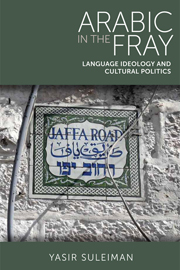55 results
Conclusion
-
- Book:
- Arabic in the Fray
- Published by:
- Edinburgh University Press
- Published online:
- 05 October 2013
- Print publication:
- 22 July 2013, pp 277-280
-
- Chapter
- Export citation
Index
-
- Book:
- Arabic in the Fray
- Published by:
- Edinburgh University Press
- Published online:
- 05 October 2013
- Print publication:
- 22 July 2013, pp 297-308
-
- Chapter
- Export citation
4 - Hybridity, Language Ideology and Cultural Politics
-
- Book:
- Arabic in the Fray
- Published by:
- Edinburgh University Press
- Published online:
- 05 October 2013
- Print publication:
- 22 July 2013, pp 167-219
-
- Chapter
- Export citation
Introduction
-
- Book:
- Arabic in the Fray
- Published by:
- Edinburgh University Press
- Published online:
- 05 October 2013
- Print publication:
- 22 July 2013, pp 1-12
-
- Chapter
- Export citation
1 - Language Construction and Language Symbolism
-
- Book:
- Arabic in the Fray
- Published by:
- Edinburgh University Press
- Published online:
- 05 October 2013
- Print publication:
- 22 July 2013, pp 13-50
-
- Chapter
- Export citation
5 - Through the Looking Glass: Arabic, Thought and Reality
-
- Book:
- Arabic in the Fray
- Published by:
- Edinburgh University Press
- Published online:
- 05 October 2013
- Print publication:
- 22 July 2013, pp 220-276
-
- Chapter
- Export citation
Dedication
-
- Book:
- Arabic in the Fray
- Published by:
- Edinburgh University Press
- Published online:
- 05 October 2013
- Print publication:
- 22 July 2013, pp xi-xii
-
- Chapter
- Export citation
Contents
-
- Book:
- Arabic in the Fray
- Published by:
- Edinburgh University Press
- Published online:
- 05 October 2013
- Print publication:
- 22 July 2013, pp v-vi
-
- Chapter
- Export citation
Acknowledgements
-
- Book:
- Arabic in the Fray
- Published by:
- Edinburgh University Press
- Published online:
- 05 October 2013
- Print publication:
- 22 July 2013, pp viii-x
-
- Chapter
- Export citation
3 - Framing Arabic: Paratexts, Poetry and Language Ideology
-
- Book:
- Arabic in the Fray
- Published by:
- Edinburgh University Press
- Published online:
- 05 October 2013
- Print publication:
- 22 July 2013, pp 93-166
-
- Chapter
- Export citation
2 - (In)imitability, (Un)translatability and Inter-Group Strife
-
- Book:
- Arabic in the Fray
- Published by:
- Edinburgh University Press
- Published online:
- 05 October 2013
- Print publication:
- 22 July 2013, pp 51-92
-
- Chapter
- Export citation
Bibliography
-
- Book:
- Arabic in the Fray
- Published by:
- Edinburgh University Press
- Published online:
- 05 October 2013
- Print publication:
- 22 July 2013, pp 281-296
-
- Chapter
- Export citation
List of Figures
-
- Book:
- Arabic in the Fray
- Published by:
- Edinburgh University Press
- Published online:
- 05 October 2013
- Print publication:
- 22 July 2013, pp vii-vii
-
- Chapter
- Export citation

Arabic in the Fray
- Language Ideology and Cultural Politics
-
- Published by:
- Edinburgh University Press
- Published online:
- 05 October 2013
- Print publication:
- 22 July 2013
Frontmatter
-
- Book:
- Arabic in the Fray
- Published by:
- Edinburgh University Press
- Published online:
- 05 October 2013
- Print publication:
- 22 July 2013, pp i-iv
-
- Chapter
- Export citation
Preface
-
- Book:
- Living Islamic History
- Published by:
- Edinburgh University Press
- Published online:
- 12 September 2012
- Print publication:
- 21 April 2010, pp xiii-xviii
-
- Chapter
- Export citation
Acknowledgements
-
- Book:
- Living Islamic History
- Published by:
- Edinburgh University Press
- Published online:
- 12 September 2012
- Print publication:
- 21 April 2010, pp vii-vii
-
- Chapter
- Export citation
List of Contributors
-
- Book:
- Living Islamic History
- Published by:
- Edinburgh University Press
- Published online:
- 12 September 2012
- Print publication:
- 21 April 2010, pp 309-312
-
- Chapter
- Export citation
Professor Carole Hillenbrand: List of Publications
-
- Book:
- Living Islamic History
- Published by:
- Edinburgh University Press
- Published online:
- 12 September 2012
- Print publication:
- 21 April 2010, pp viii-xii
-
- Chapter
- Export citation
Bibliography
-
- Book:
- Living Islamic History
- Published by:
- Edinburgh University Press
- Published online:
- 12 September 2012
- Print publication:
- 21 April 2010, pp 279-308
-
- Chapter
- Export citation

